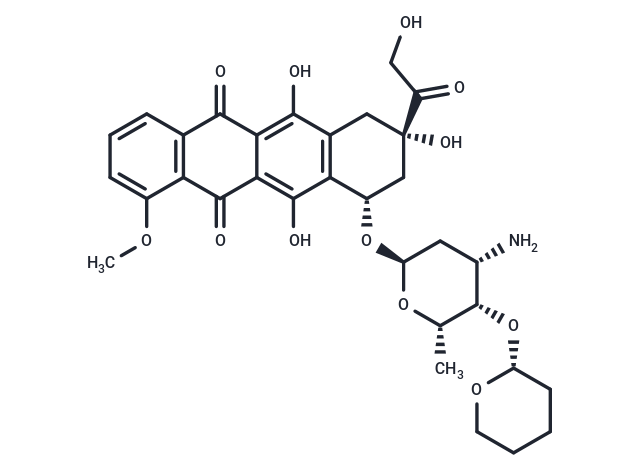Shopping Cart
- Remove All
 Your shopping cart is currently empty
Your shopping cart is currently empty

Pirarubicin (Theprubicin) is an anthracycline antibiotic. It is also a DNA/RNA synthesis inhibitor that intercalates into DNA and interacts with topoisomerase II, utilized as an antineoplastic agent.

| Pack Size | Price | Availability | Quantity |
|---|---|---|---|
| 5 mg | $32 | In Stock | |
| 10 mg | $52 | In Stock | |
| 25 mg | $108 | In Stock | |
| 50 mg | $198 | In Stock | |
| 100 mg | $342 | In Stock |
| Description | Pirarubicin (Theprubicin) is an anthracycline antibiotic. It is also a DNA/RNA synthesis inhibitor that intercalates into DNA and interacts with topoisomerase II, utilized as an antineoplastic agent. |
| In vitro | Pirarubicin is rapidly taken up by M5076 cells and the intracellular concentration of pirarubicin reaches more than 2.5-fold that of doxorubicin. Pirarubicin is more effective than doxorubicin in terms of the 50% cell growth-inhibitory concentration in vitro. [1] Pirarubicin causes G0/G1 cell cycle arrest in MG-63 cells. Pirarubicin suppresses the expression of PCNA, cyclin D1, cyclin E and Bcl-2, and increases Bax expression in MG-63 cells. [2] Pirarubicin markedly relaxes contractions induced by noradrenaline (0.1 μM) in the aorta with endothelium, but not in that without endothelium. Pirarubicin-induced relaxation is inhibited by methylene blue (5 μM), hydroquinone (100 μM), phenidone (50 μM), haemoglobin (1 μM) and p-bromophenacyl bromide (50 μM), but not by indomethacin (25 μM). [3] Pirarubicin is approximately 2-5 times more potent than Adriamycin in SKUT1B, HEC1A, and BG1 cell lines. Pirarubicin also displays a reverse dose-response pattern of G2 block so that at high dose, cell cycle kinetics would mirror those of untreated controls. [4] |
| In vivo | Pirarubicin reduces the tumor weight to 60% of the control level in M5076 solid tumor-bearing mice, although doxorubicin has no effect. [1] Pirarubicin and Epirubicin are effective against V x 2 tumor when injected via the hepatic intra-arterial (h.i.a.) route, the activity of Pirarubicin is stronger than that of Epirubicin. [5] |
| Alias | THP, Theprubicin |
| Molecular Weight | 627.64 |
| Formula | C32H37NO12 |
| Cas No. | 72496-41-4 |
| Smiles | COc1cccc2C(=O)c3c(O)c4C[C@](O)(C[C@H](O[C@H]5C[C@H](N)[C@H](O[C@@H]6CCCCO6)[C@H](C)O5)c4c(O)c3C(=O)c12)C(=O)CO |
| Relative Density. | 1.51 g/cm3 |
| Storage | Powder: -20°C for 3 years | In solvent: -80°C for 1 year | Shipping with blue ice. | |||||||||||||||
| Solubility Information | Ethanol: < 1 mg/mL (insoluble or slightly soluble) H2O: < 1 mg/mL (insoluble or slightly soluble) DMSO: 6.26 mg/mL (9.98 mM), Sonication is recommended. | |||||||||||||||
Solution Preparation Table | ||||||||||||||||
DMSO
| ||||||||||||||||

Copyright © 2015-2024 TargetMol Chemicals Inc. All Rights Reserved.